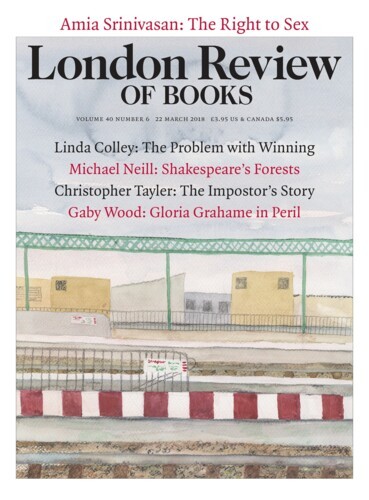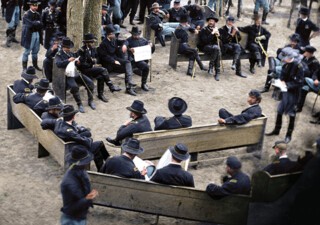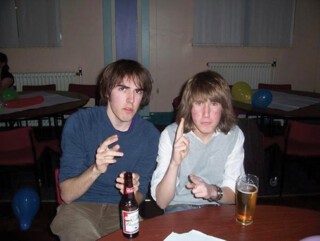‘What was it like growing up in black and white?’ was a question I asked my mother once. Until that moment her memories of childhood, so much more engrossing than any bedtime story, had unspooled in my head in perfect greyscale. (They do still, in childish defiance of the facts.) It wasn’t as if I’d seen many photographs of her as a girl – I still haven’t – but simply that the past, as I had perceived it, was defined by an absence of colour. No one who grew up in the age of black and white photography and film could have suffered under the same illusion. But nor, until relatively recently, would a child’s perception of the past have been necessarily, or primarily, defined by images: things, like cuttings of hair, hand-me-downs of varying kinds, or bits of landscape, performed similar functions, alongside oral tradition. The imagination was a freer, wilder thing. As our world has become increasingly mediated by visual culture, especially photography, so has our sense of history.
The current vogue for digitally colourised historical photographs – well represented by Retrographic: History’s Most Exciting Images Transformed into Living Colour, edited by Michael D. Carroll (Carpet Bombing Culture, £19.95) – is a marker of our level of estrangement. Take Marina Amaral’s brilliant rendering of a photograph of one of Ulysses S. Grant’s councils of war in 1864, the Union command seated on pews carried out into the grounds of Massaponax Church, Virginia: we see, as we don’t in the original, the cracked dry ground, churned black in places, the bright daylight and the shine on the men’s boots, the blue and yellow of their uniforms. Details that were fuzzy in monochrome are sharpened: the man crouched behind Grant in a haze of cigarette smoke, the closely cropped head of a man with his back to us at the bottom right. It looks like what it is: a meeting of soldiers, reading, talking, staring into space, some looking directly at the camera, one man twisted round as if he’s just heard something. And then the jolt: it is 1864, and there’s a war on. Colour does this. We are so accustomed to the muffling effect of black and white – which now conveys, almost as if that were its original purpose, chronological distance, and which tells us, quietly but insistently, that what we’re looking at is over and done with – that its sudden removal thrusts us into a present, though not our own.
Last year the BBC filmed high street shoppers being shown another of Amaral’s colourised photographs, this time of Lewis Powell, one of the men who conspired with John Wilkes Booth to assassinate Lincoln, and who on the same night made a savage attempt on the life of his secretary of state, William H. Seward. The shoppers were asked when they thought it had been taken. Powell is leaning against the pocked metal of his cell onboard the USS Saugus, where he was being held, his manacles just in sight; he is moodily handsome, in a round-necked shirt, his hair greased into a slouching side-parting, with a hint of five o’clock shadow. ‘Now,’ one woman guesses; ‘2007,’ says another, admirably specific. On 7 July 1865, a scorching hot day, Powell and three others were hanged. One of the photographs in Retrographic, colourised by Mads Madsen, is of the scaffold: Powell, who looks to be wearing the same outfit as on the Saugus, is stood in his socks, his legs bound, a hood over his head; a man in a brown hat, shaded by one of several umbrellas, is adjusting the noose. Powell’s co-conspirators, George Atzerodt and David Herold, still have their heads free: their expressions – private reckoning, a kind of baffled fear – are legible on their faces. A large man in a white coat and Panama hat is fussing round them, carrying with him the incongruous atmosphere of a summer fête. Mary Surratt, who owned the boarding house Booth’s gang had used for their rendezvous, is sitting in a chair on the far left, blocked from view; someone is kneeling in front of her, adjusting her hood – we can see the upturned sole of his shoe, the leather catching the light. She would be the first woman executed by the US government. A gang of Union soldiers line the top of the picture, looking down from a high wall, against a shimmering sky. The heat is palpable. Is the image more disturbing for being in colour? Without a doubt.
Why this should be the case is at one level obvious. ‘Just as we have smell memories, we have colour memories,’ the photographer Joel Meyerowitz told the Guardian recently, ‘I mean the world is in colour, right?’ But it’s clear something else is going on. ‘Through the added layers of true colour onto the originals, the people and scenes from the past appear to come to life,’ writes Jeff Vickers, Fenton Medal Ambassador to the Royal Photographic Society, in the foreword to Retrographic. When you look at a colourised photograph, Amaral told the BBC, ‘you can feel that it was real.’ That the realness of history is surprising shouldn’t really be a surprise. For many of us, perhaps most of us, history’s distance is a psychological necessity. Images turn the past into a series of signifiers: swords and sandals, doublets and hose, caps and bonnets, pinstripes and bowlers. The past is safe: an idyll, a retreat, an alien world placed under glass, specimens of humanity. Or it is a threat, a contagion: it is violence, sickness, compound error. One thing we seem quite sure of, currently, is that we don’t want history to repeat itself. Colourised photographs collapse time, flatten it, make a continuous present, if only for an instant, and our traditional defences against the past wobble. We can feel that it was real – and, in that instant, our comfortable insistence that the past is a foreign country becomes suspect. It could have been yesterday. He might have been me.
It is increasingly difficult to achieve distance. We are living, according to Carroll, in the ‘Third Age of Photography’, after black and white (1826-1970) and colour film (1970-2000): digital colour photographs are the norm, and they exist virtually, bleeding across devices and the web, rather than being stored ‘in physical photo-albums, sleeves [or] boxes and drawers’. It is the ‘Third Age’ that has made possible precise new methods of digital colourisation and given the enterprise of reworking historical photographs fresh life: practitioners have millions of images available to them, they can conduct deep research with relative ease (there are online communities committed to assisting with accurate colour choices – plastic model army kits are useful, apparently, as are BBC costume dramas), and they can find an appreciative audience for their work. Marina Amaral is self-trained, 22 years old, and lives in Brazil – she has a book of her own coming out later this year.
Another consequence of the ‘Third Age’, for those who have grown up in it, is that our histories have been lived, partly, online. At some point last year, I Googled myself – I was trying to take a short cut to something I’d written, though I won’t pretend I haven’t done it for other reasons – and noticed an image of my 17-year-old self at the top of the page. I clicked through, and realised it was taken from my Myspace profile, abandoned for 11 years, but, mortifyingly, still publicly accessible. My immediate reaction was to try to delete it, but I couldn’t – still can’t – remember my password, or the email address I used. So, anyone can see the picture I chose as my best face to the world in the early part of 2007. I’m in my bedroom, in a house my parents no longer own (they’re no longer together, either). The perspective, fashionably angled up from under my chin, makes it look as though I took it myself, though I didn’t. I remember thinking my hair looked good – it was long and fairly disgusting, as even I was aware (I grew it to cover my acne), but here it’s flicking off and curling away in interesting directions. I was especially pleased because my skin didn’t look so bad, but my lips are cracked from the medication I was taking. There are other photos. One taken the first time I got drunk, at someone’s 18th birthday party in a town hall: I’m sat at a table, a pint in front of me, two sad balloons floating in the background. I can remember walking over to that table with that pint, the cold wet weight of adulthood in my hand. There’s another of me on the night I lost my virginity, the first time round. I look happier than I felt, and I don’t even look that happy.
All this before Myspace turned into a graveyard. There are more than two thousand photos of me on Facebook, its all-conquering rival, dating from the time I started at university and running up to the present. A decade in a normal person’s life can now be recorded in a depth, and on a scale, previously afforded (and affordable) only to kings. Some of my nights out are better documented than whole wars. And it is not only a matter of quantity, but of accessibility: with a few clicks I can peel back the layers of my life faster than I can an onion. Almost every photo has its context, is locked into a sequence, dated, grouped, protected even from memory’s tender ablutions, its merciful excisions. Here I am at freshers’ week, arms slung round people who a few days later I wouldn’t have touched with a bargepole, an intimacy unthinkable were it not for these photos reminding me it once existed; in that pink blazer that seemed such a good idea at the time; with that mullet that seemed a good idea to no one, including the hairdresser, who left the area soon afterwards. Here is my dog, Alfie, who died stiff and thin-limbed in December, suspended magically in the air, a tennis ball drawing him up like a magnet. It’s not only photographs: every message I’ve ever sent, every comment, every ‘like’, is potentially recoverable. There is a video of me singing a verse from ‘Gladstone and Disraeli: The Musical’, regrettably still unstaged. And it isn’t just me, of course: it is my friends, and the friends of my friends, and my ‘friends’, and their ‘friends’, and the strangers we met once in a hostel in Zagreb and that nice woman I once sat next to on the night bus who now lives in Vietnam with her husband whom I also met and who looks vaguely like Ryan Gosling and definitely did on the night bus but now doesn’t really – capillaries of chance encounters. It is a vast archive of the self; a memory economy.
As William Davies pointed out in the LRB of 13 July last year, our relationship to time changes when we can’t establish distance from the past, from our pasts. But if he is right that this is changing politics – rewarding older, ‘authentic’ politicians with the equivalents of ‘rich credit histories’ – it still isn’t clear what it’s doing to our sense of ourselves. ‘History itself is made more robust through being interesting to those who come after us,’ according to Jeff Vickers, making the case for the value of colourised photographs, especially for the young. Carroll tells us that we can ‘justify’ colourisation ‘by recognising that we share the photographic moment more authentically with the photographer, and the subject, when we view it in colour’. Maybe. It may also make us less scrupulous and more sentimental, disinclined to think outside the frame. Sharing isn’t always caring. One thing we do know for sure is that huge numbers of us have handed over our own memories to a corporation, and that it wants us to remember. For now, only what we were doing this time last year, three years ago, ten. But it also wants us to keep moving, to make more memories, to change. Facebook likes to send me messages: ‘You last updated your profile 24 weeks ago.’ Time is a noose, tightening round our necks.
Send Letters To:
The Editor
London Review of Books,
28 Little Russell Street
London, WC1A 2HN
letters@lrb.co.uk
Please include name, address, and a telephone number.



